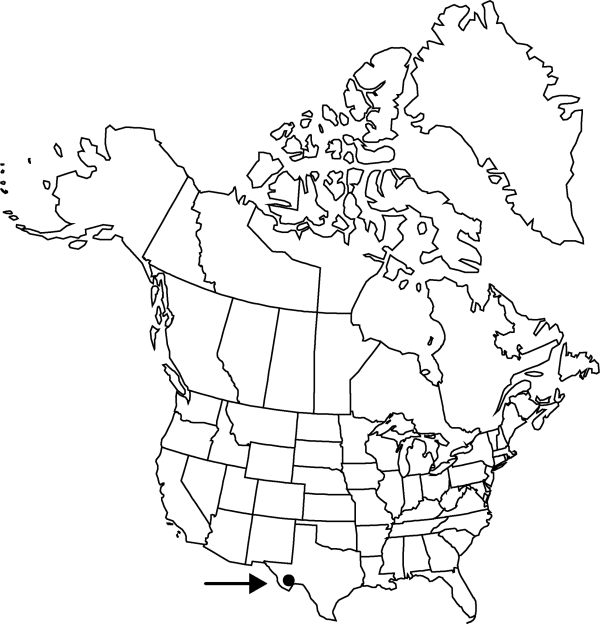Difference between revisions of "Coryphantha hesteri"
Cact. Succ. J. (Los Angeles) 4: 274, fig. (p. 273). 1932.
FNA>Volume Importer |
FNA>Volume Importer |
||
| Line 28: | Line 28: | ||
|distribution=Tex. | |distribution=Tex. | ||
|discussion=<p>Of conservation concern.</p><!-- | |discussion=<p>Of conservation concern.</p><!-- | ||
| − | --><p>Coryphantha hesteri resembles C. vivipara but is much smaller in all parts. Coryphantha hesteri is characteristic of the dwarf cacti on novaculite outcrops but is not limited to that substrate.</p> | + | --><p><i>Coryphantha hesteri</i> resembles <i>C. vivipara</i> but is much smaller in all parts. <i>Coryphantha hesteri</i> is characteristic of the dwarf cacti on novaculite outcrops but is not limited to that substrate.</p> |
|tables= | |tables= | ||
|references= | |references= | ||
| Line 52: | Line 52: | ||
|publication year=1932 | |publication year=1932 | ||
|special status= | |special status= | ||
| − | |source xml=https://jpend@bitbucket.org/aafc-mbb/fna-data-curation.git/src/ | + | |source xml=https://jpend@bitbucket.org/aafc-mbb/fna-data-curation.git/src/8f726806613d60c220dc4493de13607dd3150896/coarse_grained_fna_xml/V4/V4_427.xml |
|subfamily=Cactaceae subfam. Cactoideae | |subfamily=Cactaceae subfam. Cactoideae | ||
|genus=Coryphantha | |genus=Coryphantha | ||
Revision as of 17:28, 18 September 2019
Plants unbranched, except in old age, ultimately forming dense clumps, 5–20(–30) cm diam., stem not obscured by spines when hydrated, obscured when desiccated. Roots short, fleshy, enlarged taproots, basally ± 1/3–1/2 of stem diam. Stems deep-seated, aerial parts inconspicuous, flat-topped to hemispheric (to ovoid or spheric in horticulture), almost completely withdrawing into substrate when desiccated, (2.4–)5–9 × 1.5–4.7 cm, above-ground portion 1–6.5(–9); tubercles 5–9(–12) × 4–6(–7) mm; areolar glands absent; parenchyma not mucilaginous; druses present, largest druses lenticular, 0.3–0.5 mm diam.; pith 1/5–1/3 of lesser stem diam.; medullary vascular system not recorded. Spines (12–)15–20(–25) per areole, white with brown tips (quickly weathering to gray) or the adaxial spines per areole dark gray-brown throughout; all radial spines or 1–3 adaxial spines sometimes interpreted as central, laterally compressed at base, 6–13 × (0.1–)0.2–0.3 mm; subcentral spines 0(–3) per areole; central spines 0(–3) per areole, appressed, straight, ± equal, 9.5–13(–15) × 0.2–0.3 mm. Flowers nearly apical, 18–25 × 20–34 mm; outer tepals fringed; inner tepals 22–27 per flower, bright rose-pink or magenta, proximally paler, 10–17 × 2–4 mm; outer filaments colorless or white to rose; anthers orange-yellow; stigma lobes (4–)5–6(–7), white, cream, or pale pink, 1–3 mm. Fruits green, spheric or obovoid, (3.5–) 5–8(–10) × 3–6 mm, quickly drying; floral remnant usually persistent. Seeds dark brown, spheric, 0.9–1.1(–1.2) mm, pitted. 2n = 22.
Phenology: Flowering Apr–Jun(-Nov); fruiting Aug–Oct(-Jan).
Habitat: Semidesert grasslands, oak-juniper-pinyon woodlands, rock crevices, rocky soils, sandstone, limestone, igneous substrates, novaculite
Elevation: 1200-1600 m
Discussion
Of conservation concern.
Coryphantha hesteri resembles C. vivipara but is much smaller in all parts. Coryphantha hesteri is characteristic of the dwarf cacti on novaculite outcrops but is not limited to that substrate.
Selected References
None.
